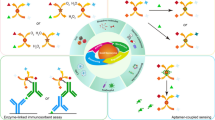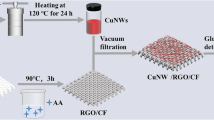Abstract
The exploration of substrate materials to construct electrochemical biosensors for glucose monitoring in the field of clinical diagnosis, especially for diabetes is still being investigated extensively. In this paper, NiO/Fe2O3 nanocomposites are designed and synthesized by two-step hydrothermal approach in combination with calcinations. The morphology and microstructure are studied by SEM, XRD, XPS, and TEM systematically. Optimized NiO/Fe2O3 nanocomposites are employed as substrate to construct glucose biosensors, and the electrochemical properties are carried out by cyclic voltammetric and chronoamperometric techniques. The results indicate as-prepared biosensors achieve a high sensitivity of 230.5 μA cm−2 mM−1, wide linear range between 50 and 2867 μM, and low detection limit of 3.9 μM towards glucose detection. The synergistic effect between NiO and Fe2O3 as substrate to construct glucose biosensors is elucidated. The selectivity is acceptable based on the detection of glucose concentration for diabetics.






Similar content being viewed by others
References
Wang J (2008) Electrochemical glucose biosensors. Chem Rev 108(2):814–825. https://doi.org/10.1021/cr068123a
Ronkainen NJ, Halsall HB, Heineman WR (2010) Electrochemical biosensors. Chem Soc Rev 39(5):1747–1763. https://doi.org/10.1039/b714449k
Yang M, Qu F, Lu Y, He Y, Shen G, Yu R (2006) Platinum nanowire nanoelectrode array for the fabrication of biosensors. Biomaterials 27(35):5944–5950. https://doi.org/10.1016/j.biomaterials.2006.08.014
Wang Y, Zhu Y, Chen J, Zeng Y (2012) Amperometric biosensor based on 3D ordered freestanding porous Pt nanowire array electrode. Nano 4:6025–6031
Zhai D, Liu B, Shi Y, Pan L, Wang Y, Li W, Zhang R, Yu G (2013) Highly sensitive glucose sensor based on Pt nanoparticle/polyaniline hydrogel heterostructures. ACS Nano 7(4):3540–3546. https://doi.org/10.1021/nn400482d
Cui J, Adeloju SB, Wu Y (2014) Integration of a highly ordered gold nanowires array with glucose oxidase for ultra-sensitive glucose detection. Anal Chim Acta 809:134–140. https://doi.org/10.1016/j.aca.2013.11.024
German N, Kausaite-Minkstimiene A, Ramanavicius A, Semashko T, Mikhailova R, Ramanaviciene A (2015) The use of different glucose oxidases for the development of an amperometric reagentless glucose biosensor based on gold nanoparticles covered by polypyrrole. Electrochim Acta 169:326–333. https://doi.org/10.1016/j.electacta.2015.04.072
Wang L, Gao X, Jin L, Wu Q, Chen Z, Lin X (2013) Amperometric glucose biosensor based on silver nanowires and glucose oxidase. Sens Actuat B: Chem 176:9–14. https://doi.org/10.1016/j.snb.2012.08.077
Li Z, Gao F, Gu Z (2017) Vertically aligned Pt nanowire array/Au nanoparticle hybrid structure as highly sensitive amperometric biosensors. Sens Actuat B: Chem 243:1092–1101. https://doi.org/10.1016/j.snb.2016.12.033
Wang H, Wang X, Zhang X, Qin X, Zhao Z, Miao Z, Huang N, Chen Q (2009) A novel glucose biosensor based on the immobilization of glucose oxidase onto gold nanoparticles-modified Pb nanowires. Biosens Bioelectron 25(1):142–146. https://doi.org/10.1016/j.bios.2009.06.022
Li C, Liu Y, Li L, Du Z, Xu S, Zhang M, Yin X, Wang T (2008) A novel amperometric biosensor based on NiO hollow nanospheres for biosensing glucose. Talanta 77(1):455–459. https://doi.org/10.1016/j.talanta.2008.06.048
Tyagi M, Tomar M, Gupta V (2012) Influence of hole mobility on the response characteristics of p-type nickel oxide thin film based glucose biosensor. Anal Chim Acta 726:93–101. https://doi.org/10.1016/j.aca.2012.03.027
Singh J, Kalita P, Singh MK, Malhotra BD (2011) Nanostructured nickel oxide-chitosan film for application to cholesterol sensor. Appl Phys Lett 98(123702):1–3
Wang S, Tan Y, Zhao D, Liu G (2008) Amperometric tyrosinase biosensor based on Fe3O4 nanoparticles-chitosan nanocomposite. Biosens Bioelectron 23(12):1781–1787. https://doi.org/10.1016/j.bios.2008.02.014
Baby TT, Ramaprabhu S (2010) SiO2 coated Fe3O4 magnetic nanoparticle dispersed multiwalled carbon nanotubes based amperometric glucose biosensor. Talanta 80(5):2016–2022. https://doi.org/10.1016/j.talanta.2009.11.010
Perez JM (2007) Iron oxide nanoparticles: hidden talent. Nature Nanotechnol 2(9):535–536. https://doi.org/10.1038/nnano.2007.282
Kaushik A, Khan R, Solanki PR, Pandey P, Alam J, Ahmad S, Malhotra BD (2008) Iron oxide nanoparticles-chitosan composite based glucose biosensor. Biosens Bioelectron 24(4):676–683. https://doi.org/10.1016/j.bios.2008.06.032
Umar A, Ahmad R, Al-Hajry A, Kim SH, Abaker ME, Hahn Y-B (2014) Spruce branched α-Fe2O3 nanostructures as potential scaffolds for a highly sensitive and selective glucose biosensor. New J Chem 38(12):5873–5879. https://doi.org/10.1039/C4NJ01148A
Baratella D, Magro M, Sinigaglia G, Zboril R, Salviulo G, Vianello F (2013) A glucose biosensor based on surface active maghemite nanoparticles. Biosens Bioelectron 45:13–18. https://doi.org/10.1016/j.bios.2013.01.043
Yang C, Xu C, Wang X (2012) ZnO/Cu nanocomposite: a platform for direct electrochemistry of enzymes and biosensing applications. Langmuir 28(9):4580–4585. https://doi.org/10.1021/la2044202
Zhao J, Mu F, Qin L, Jia X, Yang C (2015) Synthesis and characterization of MgO/ZnO composite nanosheets for biosensor. Mater Chem Phys 166:176–181. https://doi.org/10.1016/j.matchemphys.2015.09.044
Zhang X, Gu A, Wang G, Huang Y, Ji H, Fang B (2011) Porous Cu-NiO modified glass carbon electrode enhanced nonenzymatic glucose electrochemical sensors. Analyst 136(24):5175–5180. https://doi.org/10.1039/c1an15784a
Cui J, Luo J, Peng B, Zhang X, Zhang Y, Wang Y, Qin Y, Zheng H, Shu X, Wu Y (2016) Synthesis of porous NiO/CeO2 hybrid nanoflake arrays as a platform for electrochemical biosensing. Nano 8:770–774
Yang P, Ding Y, Lin Z, Chen Z, Li Y, Qiang P, Ebrahimi M, Mai W, Wong CP, Wang ZL (2014) Low-cost high-performance solid-state asymmetric supercapacitors based on MnO2 nanowires and Fe2O3 nanotubes. Nano Lett 14(2):731–73e. https://doi.org/10.1021/nl404008e
Yamashita T, Hayes P (2008) Analysis of XPS spectra of Fe2+ and Fe3+ ions in oxide materials. Appl Surf Sci 254(8):2441–2449. https://doi.org/10.1016/j.apsusc.2007.09.063
Peck MA, Langell MA (2012) Comparison of nanoscaled and bulk NiO structural and environmental characteristics by XRD, XAFS, and XPS. Chem Mater 24(23):4483–4490. https://doi.org/10.1021/cm300739y
Cai GF, Tu JP, Zhang J, Mai YJ, Lu Y, Gu CD, Wang XL (2012) An efficient route to a porous NiO/reduced graphene oxide hybrid film with highly improved electrochromic properties. Nano 4:5724–5730
Yan X, Tong X, Wang J, Gong C, Zhang M, Liang L (2014) Synthesis of mesoporous NiO nanoflake array and its enhanced electrochemical performance for supercapacitor application. J Alloy Compd 593:184–189. https://doi.org/10.1016/j.jallcom.2014.01.036
Wang G, Lu X, Zhai T, Ling Y, Wang H, Tong Y, Li Y (2012) Free-standing nickel oxide nanoflake arrays: synthesis and application for highly sensitive non-enzymatic glucose sensors. Nano 4:3123–3127
Katsuki H, Komarneni S (2001) Microwave-hydrothermal synthesis of monodispersed nanophase α-Fe2O3. J Am Ceram Soc 84:2313–2317
Ju J, Chen W (2015) In situ growth of surfactant-free gold nanoparticles on nitrogen-doped graphene quantum dots for electrochemical detection of hydrogen peroxide in biological environments. Anal Chem 87(3):1903–1910. https://doi.org/10.1021/ac5041555
Chu X, Zhu X, Dong Y, Chen T, Ye M, Sun W (2012) An amperometric glucose biosensor based on the immobilization of glucose oxidase on the platinum electrode modified with NiO doped ZnO nanorods. J Electroanal Chem 676:20–26. https://doi.org/10.1016/j.jelechem.2012.04.009
Zhao Y, Fang X, Yan X, Zhang X, Kang Z, Zhang G, Zhang Y (2014) Nanorod arrays composed of zinc oxide modified with gold nanoparticles and glucose oxidase for enzymatic sensing of glucose. Microchim Acta 182:605–610
Zhao ZW, Chen XJ, Tay BK, Chen JS, Han ZJ, Khor KA (2007) A novel amperometric biosensor based on ZnO:Co nanoclusters for biosensing glucose. Biosens Bioelectron 23(1):135–139. https://doi.org/10.1016/j.bios.2007.03.014
Long GL, Winefordner JD (1983) Limit of detection. A closer look at the IUPAC definition. Anal Chem 55:712A–724A
Lineweaver H, Burk D (1934) The determination of enzyme dissociation constants. J Am Chem Soc 56(3):658–666. https://doi.org/10.1021/ja01318a036
Feng X, Cheng HJ, Pan YW, Zheng H (2015) Development of glucose biosensors based on nanostructured graphene-conducting polyaniline composite. Biosens Bioelectron 70:411–417. https://doi.org/10.1016/j.bios.2015.03.046
Xiang D, Yin LW, Ma JY, Guo EY, Li Q, Li ZQ, Liu KG (2014) Amperometric hydrogen peroxide and glucose biosensor based on NiFe2/ordered mesoporous carbon nanocomposites. Analyst 140:644–653
Patil D, Dung NQ, Jung H, Ahn SY, Jang DM, Kim D (2012) Enzymatic glucose biosensor based on CeO2 nanorods synthesized by non-isothermal precipitation. Biosens Bioelectron 31(1):176–181. https://doi.org/10.1016/j.bios.2011.10.013
Egi M, Bellomo R, Stachowski E, French CJ, Hart GK, Hegarty C, Bailey M (2008) Blood glucose concentration and outcome of critical illness: the impact of diabetes. Criti Care Med 36(8):2249–2255. https://doi.org/10.1097/CCM.0b013e318181039a
Li Y, Song Y-Y, Yang C, Xia X-H (2007) Hydrogen bubble dynamic template synthesis of porous gold for nonenzymatic electrochemical detection of glucose. Electrochem Commun 9(5):981–988. https://doi.org/10.1016/j.elecom.2006.11.035
Funding
This work is financially supported by the National Natural Science Foundation of China (Nos. 51402081, 51502071 and 51272063) and AVIC Institute of Fundamental Technology Innovation Fund (Grant No. JCY2015A001). Dr. Jiewu Cui is grateful to the financial support from the Fundamental Research Funds for the Central Universities (No. JZ2016HGTB0719 and JZ2017HGTB0203).
Author information
Authors and Affiliations
Corresponding authors
Ethics declarations
The authors declare that they have no conflict of interest.
Electronic supplementary material
ESM 1
(DOC 28882 kb)
Rights and permissions
About this article
Cite this article
Luo, L., Cui, J., Wang, Y. et al. Synthesis of NiO/Fe2O3 nanocomposites as substrate for the construction of electrochemical biosensors. J Solid State Electrochem 22, 1763–1770 (2018). https://doi.org/10.1007/s10008-018-3882-6
Received:
Revised:
Accepted:
Published:
Issue Date:
DOI: https://doi.org/10.1007/s10008-018-3882-6




